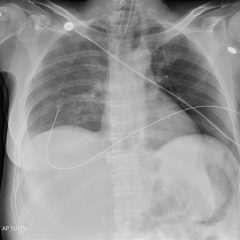Edible Cricothyrotomy Model: A Low-Cost Alternative to Pig Tracheas and Plastic Models for Teaching Cricothyrotomy
ABSTRACT
Audience:
This edible cricothyrotomy trainer is designed to teach residents and faculty the procedure of cricothyrotomy.
Introduction:
Cricothyrotomy is an essential procedure for any provider in the emergency department where the estimated incidence of a failed airway leading to surgical airway is 0.5%.1,2,3 It is challenging to obtain cost effective and realistic models to train clinicians and provide further opportunities for practice and skills maintenance.
We (RB) created a novel edible cricothyrotomy (EC) model that is made entirely of edible materials, other than the trachea, which is represented by a piece of ventilator tubing. There is a tortilla base layer, with great vessels represented by colored licorice, thyroid cartilage made from Hersheys chocolate, cricoid from gummy worm, and fruit leather platysma topped with an additional tortilla to complete the skin layer.
Objectives:
At the end of this educational session, learners will be able to: 1) list the steps involved in performing a cricothyrotomy,2) identify the laryngeal landmarks necessary to perform a successful cricothyrotomy, 3) successfully perform a cricothyrotomy, 4) deliberately practice toperform the procedure quickly and safely.
Method:
An edible cricothyrotomy model was built for each participant from the ingredients listed above. An educational session was developed to test the EC in comparison to the more traditional pig trachea (PT) and plastic model (PM). A pre- and post-survey was administered to participants to assess the usability and realism of the models as well as the learners’ comfort with the procedure. During the session, a lecture was given, and then participants rotated to all three models and were videotaped and timed performing a scalpel-finger-bougie cricothyrotomy. Times to successful completion, participant satisfaction with the models, and cost of the models were compared.
Results:
43 participants completed the educational session. All completed the pre-survey and 40 of 43 completed the post-surveys (93% response rate). Times to complete a cricothyrotomy were faster for PT (median 32 sec, Interquartile Range [IQR] 24-41 sec) and PM (median 33 sec, IQR 28-39 sec) than on the EC (44 sec, IQR 35-63). There was a statistically significant divergence in preference (p=0.0001) with participants rating the PT first (median rank 1, IQR 1-1), the EC second (median rank 2, IQR 2-2), and the PM third (median rank 3, IQR 2.5-3). Cost of the models at the time of analysis (October, 2104) was $2.77 for EC and $7.64 for PT. The plastic model was built from materials obtained in the emergency department (ventilator tubing, 4-inch white foam tape, ½ inch white tape, and Coban.) These materials were not purchased, so cost per plastic model was not calculated.
Conclusion:
A novel, edible cricothyrotomy training model is a suitable and cost effective alternative to a pig trachea and has a role for learners seeking multiple attempts at the procedure for skills maintenance and retention.
Topics:
cricothyrotomy, airway management, critical procedures.

